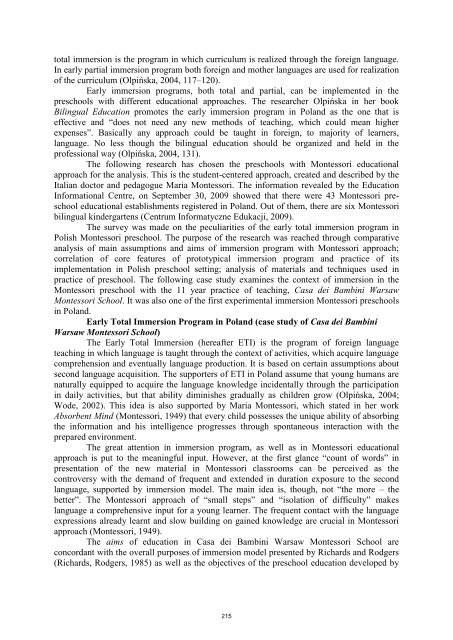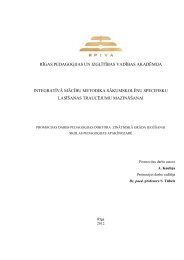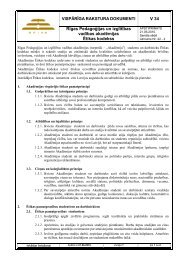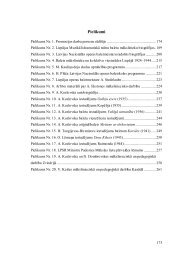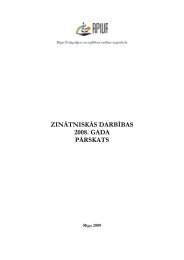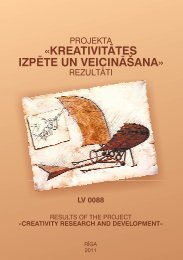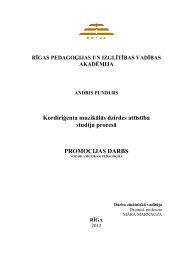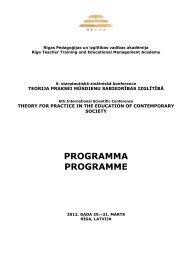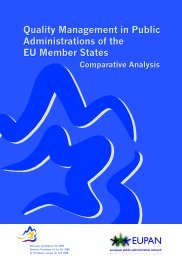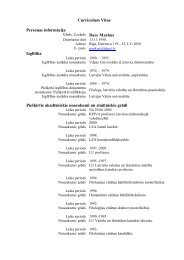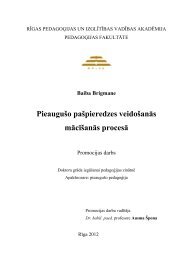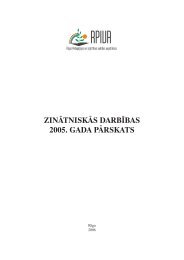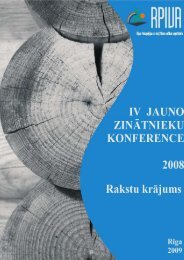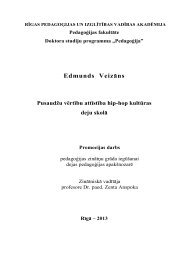saturs - rpiva
saturs - rpiva
saturs - rpiva
- No tags were found...
Create successful ePaper yourself
Turn your PDF publications into a flip-book with our unique Google optimized e-Paper software.
total immersion is the program in which curriculum is realized through the foreign language.<br />
In early partial immersion program both foreign and mother languages are used for realization<br />
of the curriculum (Olpińska, 2004, 117–120).<br />
Early immersion programs, both total and partial, can be implemented in the<br />
preschools with different educational approaches. The researcher Olpińska in her book<br />
Bilingual Education promotes the early immersion program in Poland as the one that is<br />
effective and “does not need any new methods of teaching, which could mean higher<br />
expenses”. Basically any approach could be taught in foreign, to majority of learners,<br />
language. No less though the bilingual education should be organized and held in the<br />
professional way (Olpińska, 2004, 131).<br />
The following research has chosen the preschools with Montessori educational<br />
approach for the analysis. This is the student-centered approach, created and described by the<br />
Italian doctor and pedagogue Maria Montessori. The information revealed by the Education<br />
Informational Centre, on September 30, 2009 showed that there were 43 Montessori preschool<br />
educational establishments registered in Poland. Out of them, there are six Montessori<br />
bilingual kindergartens (Centrum Informatyczne Edukacji, 2009).<br />
The survey was made on the peculiarities of the early total immersion program in<br />
Polish Montessori preschool. The purpose of the research was reached through comparative<br />
analysis of main assumptions and aims of immersion program with Montessori approach;<br />
correlation of core features of prototypical immersion program and practice of its<br />
implementation in Polish preschool setting; analysis of materials and techniques used in<br />
practice of preschool. The following case study examines the context of immersion in the<br />
Montessori preschool with the 11 year practice of teaching, Casa dei Bambini Warsaw<br />
Montessori School. It was also one of the first experimental immersion Montessori preschools<br />
in Poland.<br />
Early Total Immersion Program in Poland (case study of Casa dei Bambini<br />
Warsaw Montessori School)<br />
The Early Total Immersion (hereafter ETI) is the program of foreign language<br />
teaching in which language is taught through the context of activities, which acquire language<br />
comprehension and eventually language production. It is based on certain assumptions about<br />
second language acquisition. The supporters of ETI in Poland assume that young humans are<br />
naturally equipped to acquire the language knowledge incidentally through the participation<br />
in daily activities, but that ability diminishes gradually as children grow (Olpińska, 2004;<br />
Wode, 2002). This idea is also supported by Maria Montessori, which stated in her work<br />
Absorbent Mind (Montessori, 1949) that every child possesses the unique ability of absorbing<br />
the information and his intelligence progresses through spontaneous interaction with the<br />
prepared environment.<br />
The great attention in immersion program, as well as in Montessori educational<br />
approach is put to the meaningful input. However, at the first glance “count of words” in<br />
presentation of the new material in Montessori classrooms can be perceived as the<br />
controversy with the demand of frequent and extended in duration exposure to the second<br />
language, supported by immersion model. The main idea is, though, not “the more – the<br />
better”. The Montessori approach of “small steps” and “isolation of difficulty” makes<br />
language a comprehensive input for a young learner. The frequent contact with the language<br />
expressions already learnt and slow building on gained knowledge are crucial in Montessori<br />
approach (Montessori, 1949).<br />
The aims of education in Casa dei Bambini Warsaw Montessori School are<br />
concordant with the overall purposes of immersion model presented by Richards and Rodgers<br />
(Richards, Rodgers, 1985) as well as the objectives of the preschool education developed by<br />
215


